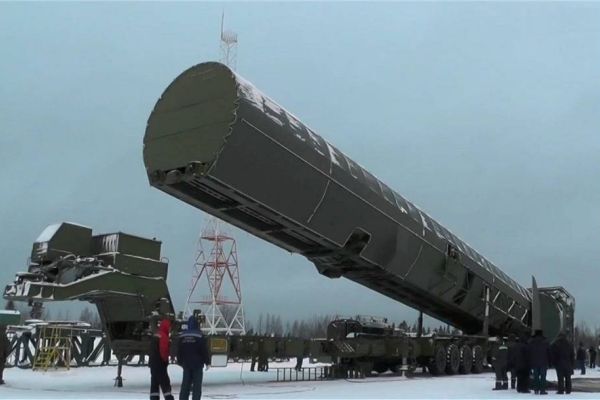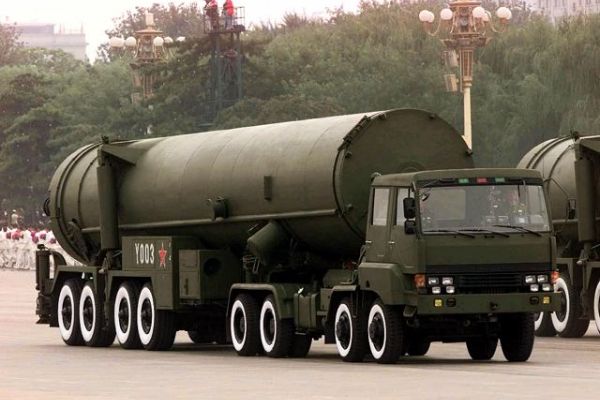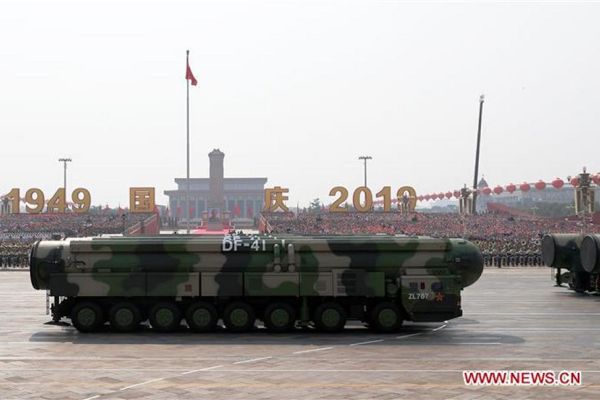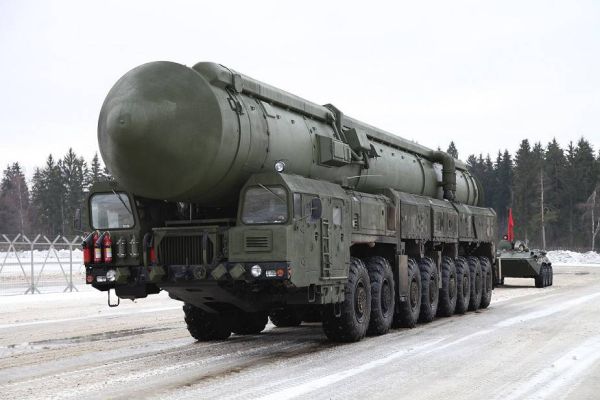ICBM Intercontinental ballistic missiles.
LGM-35A Sentinel ICBM.

The LGM-35A Sentinel is the United States' next-generation intercontinental ballistic missile (ICBM), designed to replace the long-serving LGM-30G Minuteman III. Developed under the Ground-Based Strategic Deterrent (GBSD) program, the Sentinel is the land-based component of the U.S. strategic nuclear triad for the 21st century. It features advanced solid-fuel propulsion, precision guidance, modular architecture, and improved security features—ensuring the long-term reliability and deterrence posture of the U.S. nuclear arsenal through at least the 2070s. As a silo-based ICBM, the Sentinel emphasizes hardened survivability, fast retargeting, and seamless integration into U.S. Strategic Command's digital command-and-control infrastructure.
Description
The LGM-35A Sentinel is classified as a silo-launched, solid-fuel, intercontinental ballistic missile, capable of carrying thermonuclear payloads over global ranges. It represents a complete replacement—not just an upgrade—of the Minuteman III system, with entirely new missile bodies, launch support systems, command infrastructure, and digital control architecture. It was conceived to address the diminishing effectiveness, growing cost, and cyber-vulnerabilities of the aging Minuteman fleet.
The need for a new land-based deterrent emerged in the early 2010s, when defense planners began evaluating options for maintaining the United States’ strategic ground-based nuclear capability beyond 2030. By 2015, the Department of Defense formally launched the Ground-Based Strategic Deterrent (GBSD) program to develop an entirely new ICBM system with improved performance, reliability, and adaptability.
In 2020, the U.S. Air Force selected Northrop Grumman as the prime contractor for the GBSD program, awarding a $13.3 billion engineering and manufacturing development contract. This decision followed Boeing’s withdrawal from the competition, leaving Northrop Grumman to lead a coalition of key subcontractors, including Aerojet Rocketdyne for propulsion and Lockheed Martin, Bechtel, and others for subsystems and infrastructure.
Throughout 2021 and 2022, the program advanced rapidly using cutting-edge digital engineering methods to model the missile’s performance, support facilities, and logistics network. In 2023, the Air Force conducted early integration testing and system architecture reviews as part of its push toward flight-ready prototypes. Field infrastructure at Malmstrom AFB, F.E. Warren AFB, and Minot AFB began early-stage upgrades to prepare for eventual Sentinel deployments.
A major development milestone occurred on March 6, 2025, when the U.S. Air Force and Northrop Grumman successfully conducted a full-scale qualification static fire test of the Sentinel’s stage-one solid rocket motor at Northrop Grumman’s Promontory, Utah facility. This test validated key performance metrics for the missile’s first-stage propulsion system, including burn duration, thrust stability, and thermal tolerances—marking a critical step toward system qualification and eventual flight testing.
The Sentinel is expected to achieve Initial Operational Capability (IOC) in the early 2030s, with full deployment continuing into the 2040s. Its operational life is projected to extend through 2075 and beyond, thanks to a modular, upgrade-ready design. The system is built not only to meet current strategic needs but also to evolve alongside advances in warhead technology, missile defense countermeasures, and digital warfare systems.
In terms of mission, the Sentinel’s core role is to provide a credible, survivable, and flexible nuclear deterrent from U.S. soil. It supports both single and multiple independently targetable reentry vehicle (MIRV) payloads, enhancing strategic targeting options while remaining compliant with arms control treaties, such as New START, as long as they remain in force. The Sentinel ensures rapid, assured retaliation in the event of nuclear aggression and is designed to penetrate advanced enemy missile defenses through speed, accuracy, and reentry vehicle agility.
LGM-35 Sentinel ICBM variants:
No variants at this time; in the development phase.
Technical Data
-
Launcher System
The LGM-35A Sentinel ICBM is launched from a dispersed network of reinforced underground silos, many of which are being overhauled from their Minuteman III configuration. These upgraded silos feature enhanced physical protection, electromagnetic pulse (EMP) shielding, and next-generation digital interfaces. Located across a tri-base network at F.E. Warren AFB (Wyoming), Malmstrom AFB (Montana), and Minot AFB (North Dakota), the launch network is designed for geographic dispersion and strategic survivability.
Launch operations are coordinated through fully modernized Launch Control Centers (LCCs) equipped with distributed command systems, enabling the system to remain operational even in contested electronic warfare conditions. The missile uses a cold-launch technique, in which compressed gas ejects the missile from the silo before the rocket motor ignites—minimizing launch signature and reducing wear on the launch tube.
-
Missile
The LGM-35A Sentinel ICBM is a three-stage solid-fuel intercontinental ballistic missile made from advanced composite materials to reduce weight and improve thermal performance. While exact measurements are classified, estimates suggest a length between 18 and 21 meters, a diameter of approximately 1.85 meters, and a launch mass of 36,000 to 38,000 kilograms.
The missile is capable of carrying either a single W87-1 thermonuclear warhead or multiple reentry vehicles (MIRVs). The W87-1 is a modernized variant of the Cold War-era W87, incorporating insensitive high explosives (IHE) and advanced fuzing systems. Each warhead is estimated to yield between 300 and 475 kilotons, with targeting modes that include airburst and groundburst options depending on mission requirements.
The Sentinel also introduces a modular internal layout, making it upgradeable across propulsion, guidance, and payload components. Its digital architecture allows for swift software and firmware updates, positioning it to remain adaptable as threats evolve in the coming decades.
-
Engine
A three-stage solid rocket motor system of the LGM-35A Sentinel ICBM provides propulsion, believed to be manufactured by Aerojet Rocketdyne in partnership with Northrop Grumman. The first-stage motor—successfully static-fired in March 2025—provides the initial thrust, with subsequent stages optimized for midcourse and exoatmospheric flight.
The entire propulsion stack is built for rapid ignition, efficient fuel burn, and precise trajectory control. Launch-to-burnout acceleration pushes the missile to speeds exceeding Mach 20, or approximately 7 kilometers per second. This performance allows the Sentinel to achieve its estimated range of over 13,000 kilometers, ensuring global strike capability from within the continental U.S.
Each stage likely employs thrust vectoring nozzles, allowing the missile to make trajectory adjustments during powered flight—improving both accuracy and maneuverability against potential midcourse intercept attempts.
-
Guidance Systems
The LGM-35A Sentinel ICBM is equipped with a hardened inertial guidance system, most likely augmented by military-grade satellite navigation (GPS or GNSS) to enhance midcourse correction. The system is designed to function in GPS-denied or jammed environments, relying on fault-tolerant navigation sensors and potentially celestial navigation aids such as star trackers.
The estimated circular error probable (CEP) is believed to be under 150 meters, though precise accuracy data remains classified. The guidance electronics are radiation-hardened and integrated with digi
-
Combat Use
The LGM-35A Sentinel’s primary combat role is to serve as a strategic nuclear deterrent, ensuring the United States maintains a credible and survivable second-strike capability. In the event of a nuclear attack, the Sentinel is designed to launch rapidly and retaliate with overwhelming force, thereby deterring adversaries from initiating conflict in the first place.
With a maximum range exceeding 13,000 kilometers, the missile can reach any target on Earth from its U.S.-based silos, delivering warheads at velocities above Mach 20. Each missile can carry a single or multiple reentry vehicles, each equipped with a W87-1 warhead yielding between 300 and 475 kilotons. These warheads can strike with high accuracy, destroying hardened targets such as enemy missile silos, command bunkers, air defense nodes, or critical infrastructure.
Sentinel is capable of executing both counterforce missions—targeting an adversary's military assets—and, if ever authorized, countervalue strikes against broader economic or population centers. The system's retargeting flexibility, enabled by modern digital command-and-control infrastructure, allows for rapid adjustments to strike packages in response to battlefield developments or real-time intelligence.
In terms of strategic employment, Sentinel silos are geographically dispersed and hardened against conventional and nuclear attacks, supported by redundant launch control systems and communications infrastructure. These features ensure that a significant portion of the missile force will survive even the most coordinated enemy first strike—thus reinforcing the doctrine of mutually assured destruction (MAD) and deterring any potential nuclear escalation.
Specifications
-
Type
Silo-launched Intercontinental Ballistic Missile (ICBM)
-
Country users
United States
-
Designer Country
United States
-
Guidance Systems
Inertial with GPS augmentation, CEP < 150 meters
-
Warhead
W87-1 thermonuclear (300–475 kilotons), multiple reentry vehicles MIRV-capable
-
Launcher System
Hardened underground silos with modernized control centers
-
Launch Weight Missile
Estimated 36,000–38,000 kg
-
Speed Missile
Estimated Mach 20+, or approximately 24,500 km/h (~15,220 mph / 6.8–7.5 km/s)
-
Range Missile
Over 13,000 km
-
Dimensions
Length: Estimated 18–21 m; Diameter: Approx. 1.85 m; Height: ? m





































